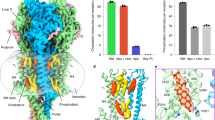Abstract
A series of 8-methyl-5-substituted indolizidines inhibit binding of the noncompetitive blocking agent [3H]perhydrohistrionicotoxin to muscle-type nicotinic acetylcholine receptor-channels in membranes fromTorpedo electroplax. The Ki values range from 0.16 to 1.12 μM, making these alkaloids among the most potent ligands for this site. Unlike most noncompetitive blockers, the potencies of the 8-methyl-5-substituted indolizidines arereduced in the presence of carbamylcholine. Indolizidine 205A (8-methyl-5-(4-pentynyl)indolizidine) is unique in enhancing binding of [3H]perhydrohistrionicotoxin by 1.5-fold. The enhancement is at a maximum at 0.01 to 0.1 μM, followed by progressive inhibition with an IC50 of about 20 μM. In the presence of carbamylcholine, which itself enhances binding of [3H]perhydrohistrionicotoxin, indolizidine 205A causes only an inhibition of binding with an IC50 of about 10 μM. Indolizidines with a hydroxy substituent on the 8-methyl group have very low activity. None of the indolizidines affect binding of [125I]α-bungarotoxin to acetylcholine recognition sites. In pheochromocytoma PC12 cells, indolizidine 205A has no agonist activity, but only inhibits carbamylcholine-elicited22Na+ influx. The profile of potencies for the 8-methyl-5-substituted indolizidines is similar in electroplax membranes and PC12 cells. Indolizidines 205A and 209B (8-methyl-5-pentylindolizidine) have no apparent effect on desensitization of receptors in PC12 cells. The 5,8-disubstituted indolizidines appear to represent an atypical and potent class of noncompetitive blockers for muscle-type and ganglionic nicotinic receptor-channels.
Similar content being viewed by others
References
Albuquerque, E. X., Daly, J. W., and Warnick, J. E. 1988. Macromolecular sites for specific neurotoxins and drugs on chemosensitive synapses and electrical excitation in biological membrane. Pages 95–162,in Narahashi, T. (ed.), Ion Channels, Vol. 1, Plenum Publishing Corp.
Aronstam, R. S., Daly, J. W., Spande, T. F., Narayanan, T. K., and Albuquerque, E. X. 1986. Interactions of gephyrotoxin and indolizidine alkaloids with the nicotinic acetylcholine receptor-ion channel complex ofTorpedo electroplax. Neurochem. Res. 11:1227–1240.
Aronstam, R. S., Edwards, M. W., Daly, J. W. and Albuquerque, E. X. 1988. Interactions of piperidine derivatives with the nicotinic cholinergic receptor complex fromTorpedo electric organ. Neurochem. Res. 13:171–176.
Aronstam, R. S., Eldefrawi, A. T., Pessah, I. N., Daly, J. W., Albuquerque, E. X., and Eldefrawi, M. E. 1981. Regulation of [3H]perhydrohistrionicotoxin binding toTorpedo ocellata electroplax by effectors of the acetylcholine receptor. J. Biol. Chem. 256:2843–2850.
Aronstam, R. S., King, C. T., Albuquerque, E. X., Daly, J. W., and Feigl, D. M. 1985. Binding of [3H]perhydrohistrionicotoxin and [3H]phencyclidine to the nicotinic receptor ion channel complex ofTorpedo electroplax: Inhibition by histrionicotoxin and derivatives. Biochem. Pharmacol. 34:3037–3047.
Burgermeister, W., Catterall, W. A., and Witkop, B. 1977. Histrionicotoxin enhances agonist-induced desensitization of acetylcholine receptor, Proc. Natl. Acad. Sci. USA 74:5754–5758.
Changeux, J.-P., Devillers-Thiery, A., and Chemouilli, P. 1984. Acetylcholine receptor: An allosteric protein. Science 225:1335–1345.
Cheng, Y. C., and Prusoff, W. H. 1973. Relationships between inhibition constant (Ki) and the concentration of inhibitor which causes 50 percent inhibition. Biochem. Pharmacol 22:3099–3108.
Collins, I., Fox, M. E., Holmes, A. B., Williams, S. F., Baker, R., Forbes, I. T., and Thompson, M. 1991. The total synthesis of (±)-indolizidines 235B and 235B″. J. Chem. Soc. Perkin Trans. I, 175–182.
Daly, J. W., Myers, C. W., and Whittaker, N. 1987. Further classification of skin alkaloids from neotropical poison frogs (Dendrobatidae), with a general survey of toxic/noxious substances in the amphibia. Toxicon 25:1023–1095.
Daly, J. W., Nishizawa, Y., Edwards, M. W., Waters, J. A., and Aronstam, R. S. 1991. Nicotinic receptor-elicited sodium flux in rat pheochromocytoma PC12 cells: Effects of agonists, antagonists, and noncompetitive blockers. Neurochem. Res. 16:489–500.
Daly, J. W., Nishizawa, Y., Padgett, W. L., Tokuyama, T., Schultz, A. G., and Aronstam, R. S. 1991. Decahydroquinoline alkaloids: Noncompetitive blockers for nicotinic acetylcholine receptor-channels in pheochromocytoma PC12 cells andTorpedo electroplax. Neurochem. Res., 16:1207–1212.
Edwards, M. W., and Daly, J. W. 1988. Alkaloids from a Panamanian poison-frog,Dendrobates speciosus (Dendrobatidae): Identification of pumiliotoxin-A and allopumiliotoxin class alkaloids, 3,5-disubstituted indolizidines, 5-substituted-8-methylindolizidines, and a 2-methyl-6-nonyl-4-hydroxypiperidine. J. Nat. Products 51:1188–1197.
Eldefrawi, A. T., Eldefrawi, M. E., Albuquerque, E. X., Oliveira, A. C., Mansour, N., Adler, M., Daly, J. W., Brown, G. B., Burgermeister, W., and Witkop, B. 1977. Perhydrohistrionicotoxin: A potential ligand for the ion conductance modulator of the acetylcholine receptor. Proc. Natl. Acad. Sci. USA 74:2172–2176.
Eldefrawi, M. E., Eldefrawi, A. T., Aronstam, R. S., Maleque, M. A., Warnick, J. E., and Albuquerque, E. X. 1980. [3H]Phencyclidine — a probe of the ionic channel of the nicotinic receptor. Proc. Natl. Acad. Sci. USA 77:7458–7462.
Holmes, A. B., Smith, A. L., Williams, S. F., Hughes, L. R., Lidert, Z., and Swithenbank 1991. Stereoselective synthesis of (±)-indolizidines 167B, 205A, and 207A. Enantioselective synthesis of (−)-indolizidine 209B. J. Org. Chem., 56:1393–1405.
Ikeda, S. R., Aronstam, R. S., Daly, J. W., Aracava, Y., and Albuquerque, E. X. 1984. Interactions of bupivacaine with ionic channels of the nicotinic receptor. Electrophysiological and biochemical studies. Mol. Pharmacol. 26:293–303.
Shishido, Y., and Kibayashi, C. 1991. The total synthesis of (−)-indolizidine 205A and 235B. J. Chem. Soc. Chem. Commun., in press.
Smith, A. L., Williams, S. F., Holmes, A. B., Hughes, L. R., Lidert, Z., and Swithenbank, C. 1988. Stereoselective synthesis of (±)-indolizidines 167B, 205A and 207A. Enantioselective synthesis of (−)-indolizidine 209B. J. Am. Chem. Soc. 110:8696–8698.
Souccar, C., Varanda, W. A., Aronstam, R. S., Daly, J. W., and Albuquerque, E. X. 1984. Interactions of gephyrotoxin with the acetylcholine receptor-ionic channel complex. II. Enhancement of desensitization. Mol. Pharmacol. 25:395–400.
Tokuyama, T., Nishimori, N., Shimada, A., Edwards, M. W., and Daly, J. W. 1987. New classes of amidine, indolizidine, and quinolizidine alkaloids from a poison-frog,Dendrobates pumilio (Dendrobatidae). Tetrahedron 43:643–652.
Warnick, J. E., Jessup, P. J., Overman, L. E., Eldefrawi, M. E., Nimit, Y., Daly, J. W., and Albuquerque, E. X. 1982. Pumiliotoxin-C and synthetic analogs. A new class of nicotinic antagonists. Mol. Pharmacol. 22:565–573.
Author information
Authors and Affiliations
Rights and permissions
About this article
Cite this article
Daly, J.W., Nishizawa, Y., Padgett, W.L. et al. 5,8-Disubstituted indolizidines: A new class of noncompetitive blockers for nicotinic receptor-channels. Neurochem Res 16, 1213–1218 (1991). https://doi.org/10.1007/BF00966698
Accepted:
Issue Date:
DOI: https://doi.org/10.1007/BF00966698




